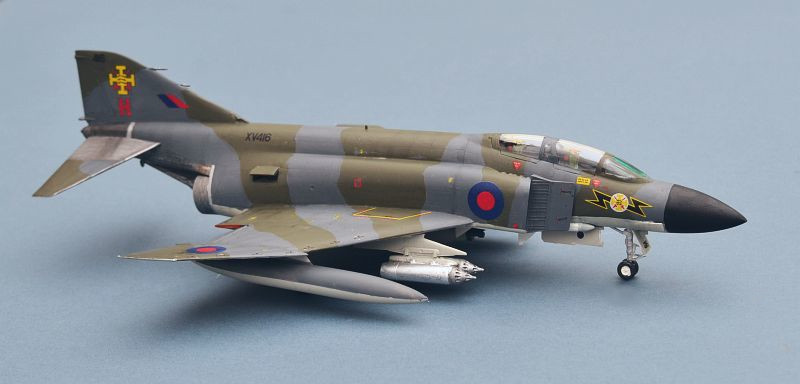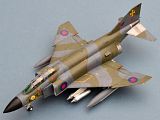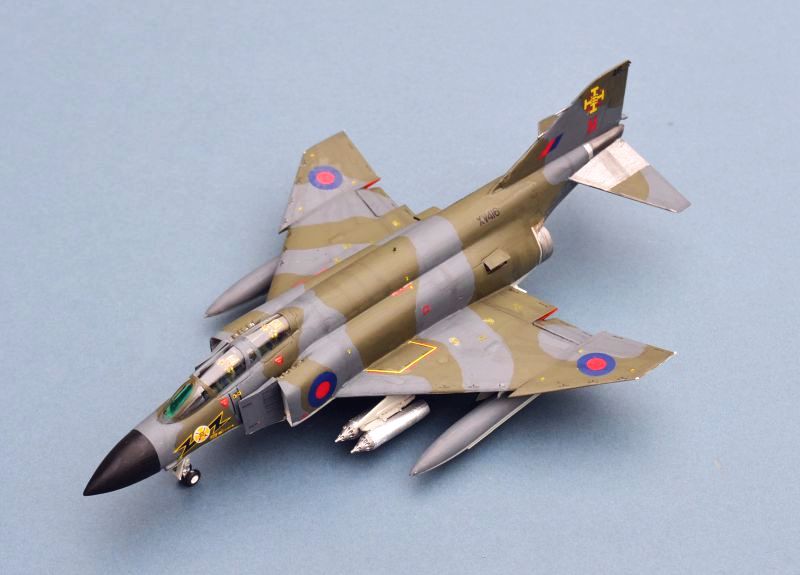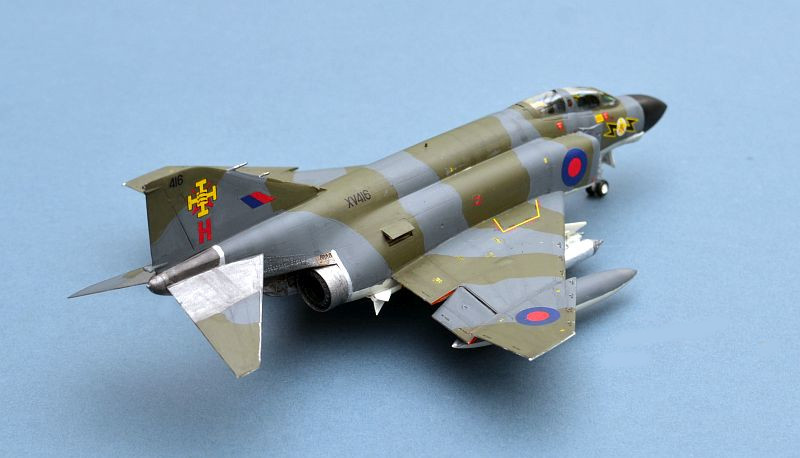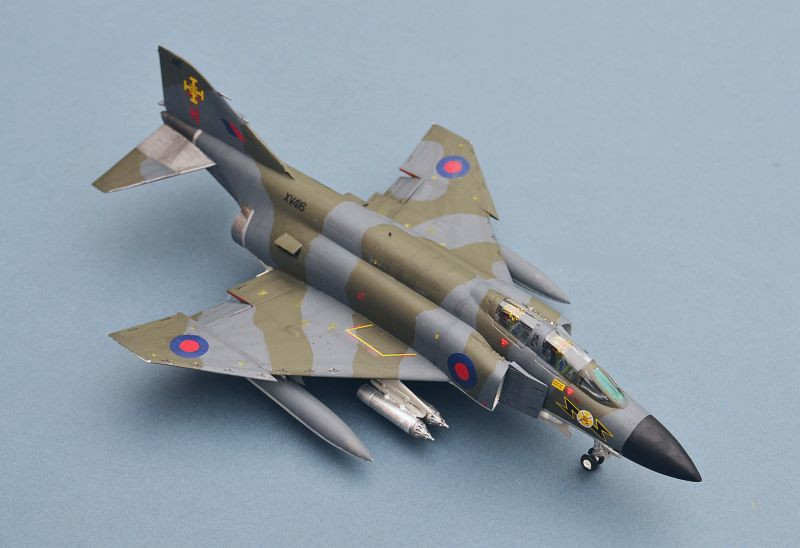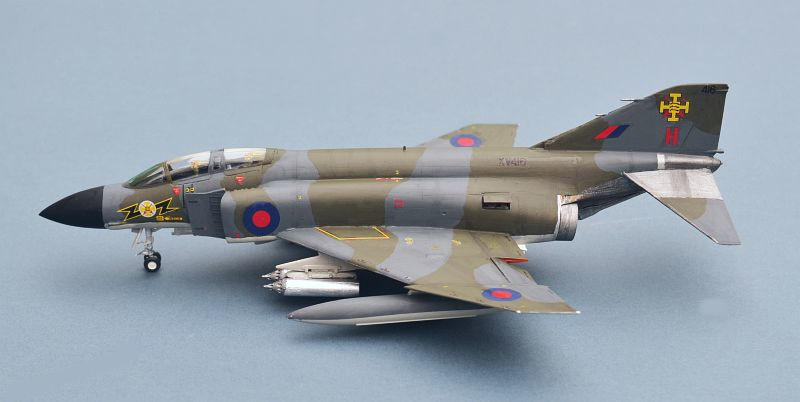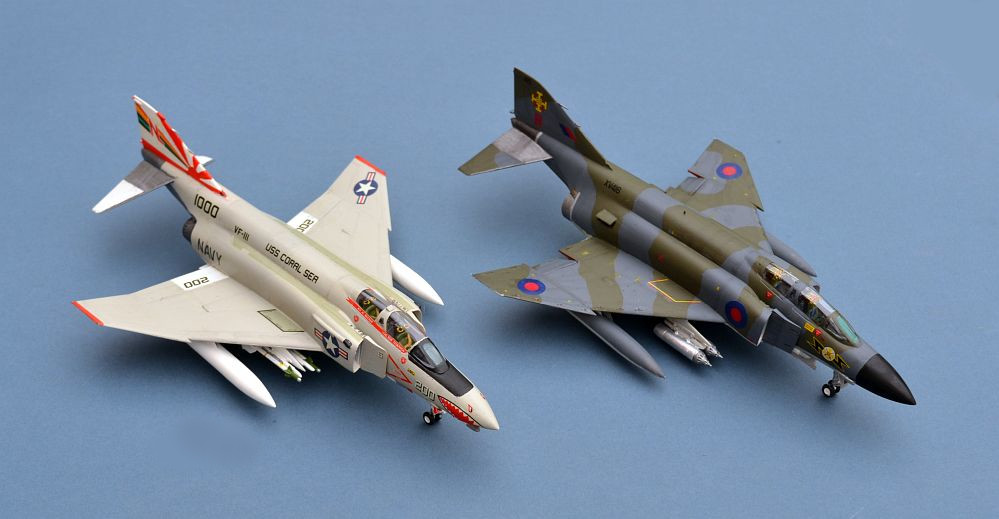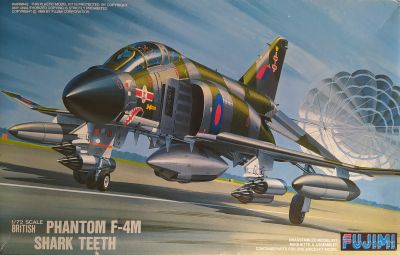May 2022
F-4N Phantom II
F-4M (FGR.2) Phantom
Link to Website Index: 
McDonnell Douglas F-4N Phantom II
VF-111 “Sundowners”, USS CORAL Sea, Vietnam 1975
Fujimi 1/72 .

Link to Website Index: 
Perhaps best known for its role in Vietnam, the Phantom began life as a US Navy all-weather
Fleet Defence Interceptor designated F4H-1. Powered by 2 General Electric J79 engines,
it was capable of Mach 2.2 at height. The first fully operational Naval version
was the F-4B, with deliveries commencing in 1961. US Navy Phantoms participated
in the very firs t raids of the Vietnam War and were present during the final withdrawals.
During the early 1970s, the US Navy began to upgrade its F-4Bs and F-4Js into the
F-4N and F-4S respectively. A complete remanufacturing programme saw war-weary aircraft
emerge almost as new”, with modernised weapons and sensor systems, plus smoke abatement
measures for the infamously smoky J-79 engines..
Project Bee Line saw 228 F-4B aircraft stripped back, re-wired and various new systems
fitted to make them into the F-4N.
Work included structural strengthening, uprated 30-kVA electrical generation, an
F-4J-style slotted stabilator. Inboard leading-edge flaps were locked shut.. ECM
and RWR antennae were added to the air intakes, under the wings and on the tip of
the tailplane. Other changes included a helmet sight System and Sidewinder Expanded
Acquisition Mode, plus a new dogfighting computer , auto-altitude reporting equipment.
New IFF and a one-way datalink. The J79-GE-8 engines of the were updated to include
smoke abatement equipment.
A similar but more extensive project for the F-4J saw combat leading edge flaps and
elements of F-14 Tomcat radar systems fitted to turn the aircraft into the F-4S.
VF-111 flew F-8 Crusaders for much of the Vietnam War, operating from a variety of
aircraft carriers, before swapping to the F-4B and USS Coral Sea in 1971, after which
it steadily transitioned onto updated F-4Ns..
Building the Fujimi F-4N Phantom Kit:
Fujimi’s Phantom kits are legendary and although originally issued in the early 1980s,
they still remain some of the best F-4 kits available, with accurate shapes, fine
engraved details and good decal selections. The late issue upgraded Fujimi British
Phantoms are the best of the series by far, but the earlier US, Japanese and German
variants are still very good, albeit with slightly less fine detail, especially in
their simplified cockpits, which nevertheless are still better than Hasegawa’s offerings
in this scale.
The kits are an easy and pleasing build, with good fit all round, requiring only
a smidgen of Tippex as a filler on some areas, most noticeably the air intake to
fuselage joint.
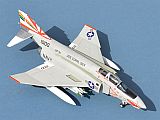
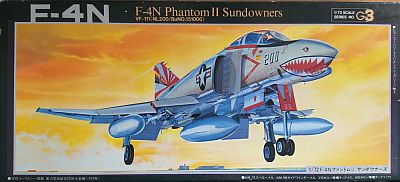
Their only real shortfall is that the kit intakes are terminated in a blank wall,
although this is not normally noticeable and common to all 1/72 Phantoms but the
newest Airfix kit. This F-4N issue includes the distinctive sensors on the top of
the fin, plus the add-on ECM sensors on the outside of the intakes. The nose IR
sensor for the F-4B variant has little guidance on th eexact position to fit and
I suspect mine is a little too far back.
Decals are bright and exciting, although in the case of my early issue kit, they
were very thin and had deteriorated showing some yellowing and becoming rather fragile,
reminding me very much of older ESCI decals. Perhaps not surprising given the age
of the kit, but I have had much older ones that were still ok.
The kit comes with an air-defence weapon load of Sparrows and Sidewinders only, which
is a little disappointing as most online pictures show VF-111s aircraft on bombing
missions.
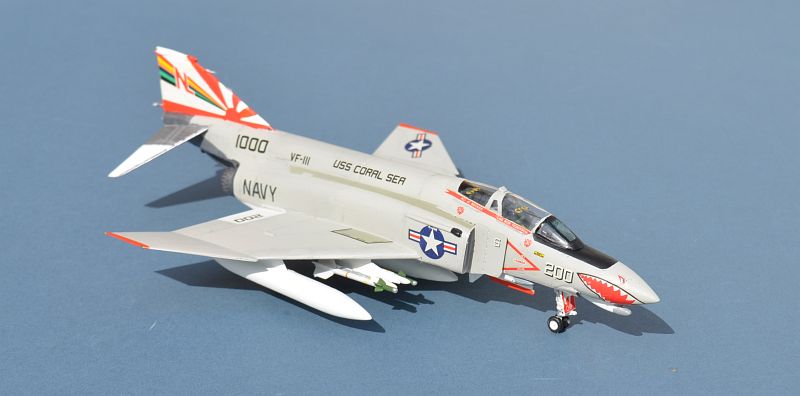
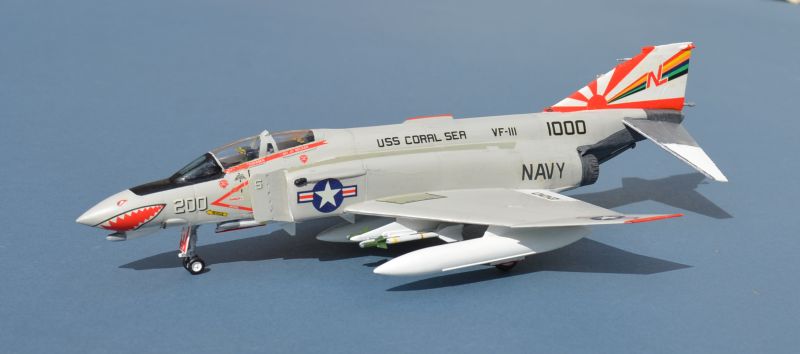
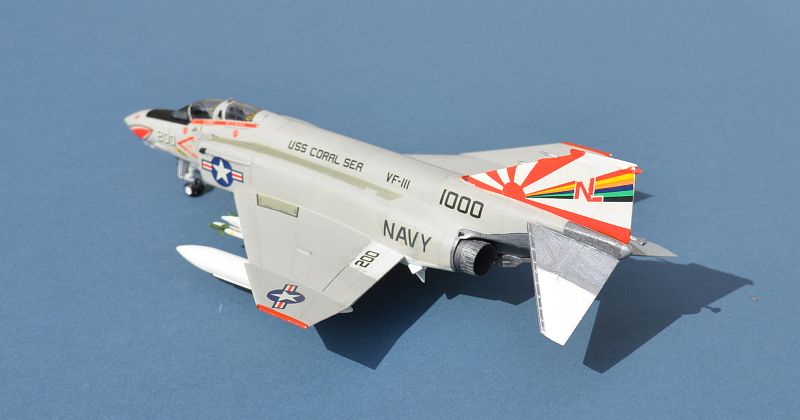
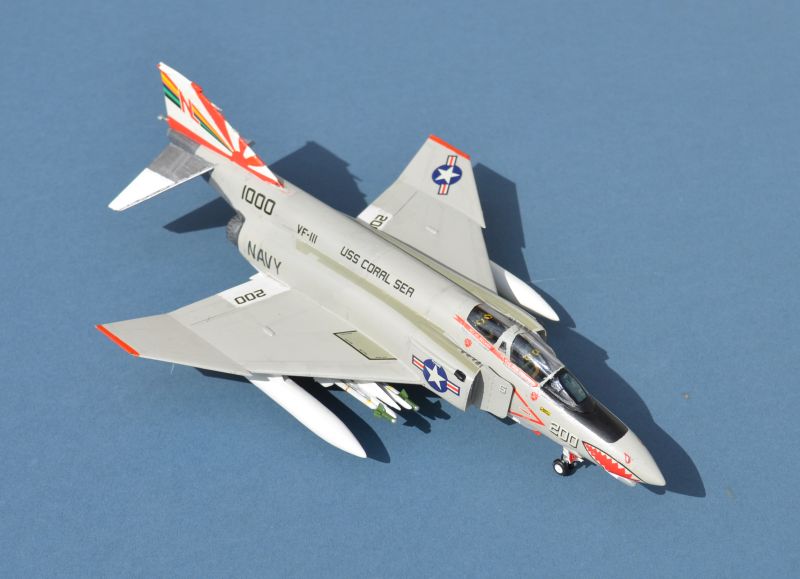
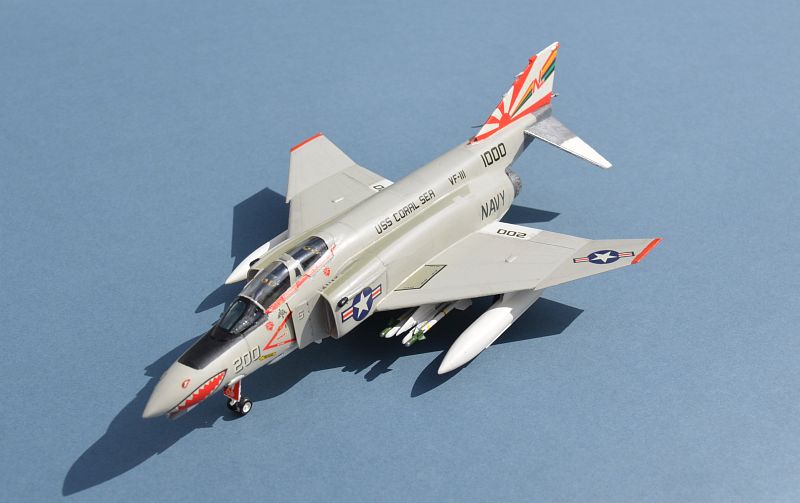
McDonnell Douglas F-4M Phantom FGR.2
111 Squadron “Tremblers” RAF Leuchars 1975
Fujimi 1/72 with Xtradecal markings.
The RAF reluctantly adopted the Phantom in 1969 following the failure of the F-111K.
The F-4M version, known in RAF service as the FGR.2, was based on the F-4K (FG.1)
originally ordered for the Royal Navy. As such it included the same British avionics
and Rolls Royce Spey engines, but since the RAF wished to operate it as a land-based
ground attack aircraft, it lacked the extending nose oleo and aerodynamic and airframe
enhancements fitted on the F-4K, such as slotted tailplanes and the folding nose.
Instead it gained a new Ferranti radar, still based on a licence built US system,
but featuring an enhanced ground mapping mode and a more sophisticated attack computer.
With the success of the SEPECAT Jaguar in the ground attack role, from the mid 1970s
the RAF began to transfer surplus FGR-2s to the UK Air Defence task where they replaced
and supplemented the existing BAC Lightnings. Not as fast or as high-flying as
the Lightning, their significantly longer range/endurance was ideal for the newly
organised and extensive UK Air Defence Regions.
Originally operating the FGR.2 from RAF Coningsby, in November 1975 111 Sqn transferred
to RAF Leuchars in Scotland to join 43 Sqn (already operating surplus RN FG.1s) policing
the very busy Northern ADR and providing air support to RN ships operating in the
North Sea and off Norway. Pictures of 43 Sqn and 111 Sqn Phantoms intercepting Soviet
Bear aircraft over the North Sea and North Atlantic quickly became familiar PR shots.
The FGR.2 was not as well suited to the Quick Reaction Alert (QRA) Air defence role
as the FG.1, for example requiring a frustrating wait before take-off to align its
nav/attack system. As a result its use by 111 Sqn was short lived, with the aircraft
swapped for ex-RN FG.1s when HMS ARK ROYAL left service in 1979.
Building the Fujimi F-4M Phantom Kit:
Fujimi’s British Phantom kits are excellent representations of the differences between
UK and non-UK variants, with larger main intakes, auxiliary engine cooling intakes,
wider, deeper rear fuselages and much bigger downward angled jet pipes. They come
with a number of enhancements compared with the US variants, including a far better
cockpit (but not perfect) a choice of multi-part or one piece canopies, plus in some
versions they include drooping flaps and upgraded vinyl wheels. Later issues are
better than the early ones, with several mould updates and error corrections.
The FGR.2 kit seems to be slightly less available than the FG.1, not least because
the FG.1 has been re-issued recently by Italeri (at half the Fujimi price). It includes
all the obvious differences between the variants,
including the non-extending nose oleo, unslotted tailplanes, plus a ground attack
or reconnaissance load of unguided rockets and strike camera or an EMI reconnaissance
pod. Four Sparrow missiles are provided although these were seldom (or only two)
carried on attack missions. Decals are typical Fujimi for that period, nicely printed
albeit with slightly ivory whites and a little thick, reminiscent in some ways of
FROG decals. Options for 4 camouflaged Coningsby based aircraft are provided (28
(OCU), 41 Sqn. 54 Sqn and 6 Sqn).
I really do like these Fujimi kits and definitely rate them more highly than even
the new Airfix mould, mainly because of their much more realistic lightly engraved
panel lines and simpler engineering.
